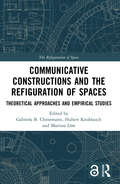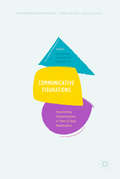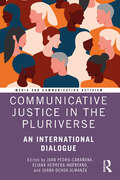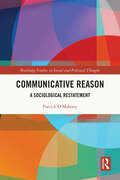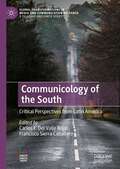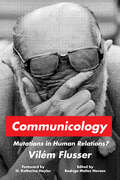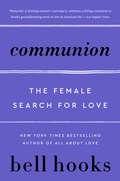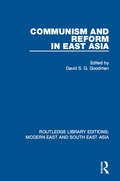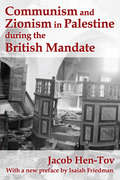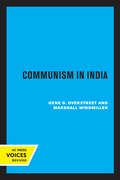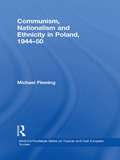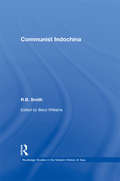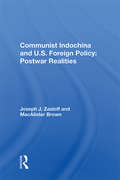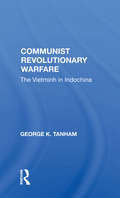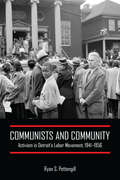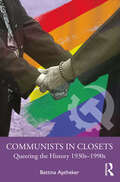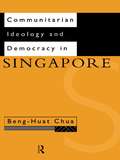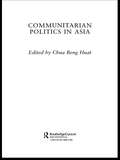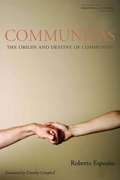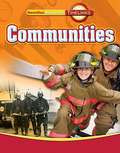- Table View
- List View
Communicative Constructions and the Refiguration of Spaces: Theoretical Approaches and Empirical Studies (The Refiguration of Space)
by Gabriela B. ChristmannThrough a variety of empirical studies, this volume offers fresh insights into the manner in which different forms of communicative action transform urban space. With attention to the methodological questions that arise from the attempt to study such changes empirically, it offers new theoretical foundations for understanding the social construction and reconstruction of spaces through communicative action. Seeing communicative action as the basic element in the social construction of reality and conceptualizing communication not only in terms of the use of language and texts, but as involving any kind of objectification, such as technologies, bodies and non-verbal signs, it considers the roles of both direct and mediatized (or digitized) communication. An examination of the conceptualization of the communicative (re-)construction of spaces and the means by which this change might be empirically investigated, this book demonstrates the fruitfulness of the notion of refiguration as a means by which to understand the transformation of contemporary societies. As such, it will appeal to sociologists, social theorists, and geographers with interests in social construction and urban space.
Communicative Figurations: Transforming Communications in Times of Deep Mediatization (Transforming Communications – Studies in Cross-Media Research)
by Andreas Hepp Andreas Breiter Uwe HasebrinkThis book is open access under a CC BY 4. 0 license. This volume is about how to research the influence of our changing media environment. Today, there is not one single medium that is the driving force of change. With the spreading of various technical communication media such as mobile phone and internet platforms, we are confronted with a media manifold of deep mediatization. But how can we investigate its transformative capability? This book answers this question by taking a non-media-centric perspective, researching the various figurations of collectivities and organizations humans are involved in. The first part of the book outlines a fundamental understanding of the changing media environment of deep mediatization and its transformative capacity. The second part focuses on collectivities and movements: communities in the city, critical social movements, maker, online gaming groups and networked groups of young people. The third part moves institutions and organizations into the foreground, discussing the transformation of journalism, religion, politics, and education, whilst the fourth and final part is dedicated to methodologies and perspectives.
Communicative Justice in the Pluriverse: An International Dialogue (Media and Communication Activism)
by Joan Pedro-Carañana Eliana Herrera-Huérfano Juana Ochoa AlmanzaThis volume examines communicative justice from the perspective of the pluriverse and explores how it is employed to work towards key pluriverse goals of environmental, cognitive, sociocultural, sociopolitical, and political economy justice. The book identifies and explains the unequal power relations in place that limit the possibilities of communication justice, the challenges and difficulties faced by activists and communities, the ways in which communities and movements have confronted power structures through discourse and material action, and their successes and limitations in creating new structures that promote the right to, and facilitate a future for, communicative justice. The volume features contributions based on experiences of resistance and transformation in the Global South—Bolivia, Ecuador, India, Malawi, and collaborations between the continents of Latin America and Africa—as well as notable studies from the Global North—Japan, Spain, and the United Kingdom—that defy hegemonic models. This book is essential for students and scholars interested in media and communication activism, media practice for development and social change, and communication for development and social change, as well as those actively engaged with activism and social justice.
Communicative Reason: A Sociological Restatement (Routledge Studies in Social and Political Thought)
by Patrick O'MahonyThe book examines philosophical and sociological approaches within critical theory and more widely from the vantage point of communicative reason. It seeks to revitalize the sociological dimension of critical theory by advancing a critical sociology of reason. It does so fully in the knowledge that reason is a contentious concept in sociology and other disciplines. Nonetheless, building on Habermas’s original insight, it argues that an extensively modified version of communicative reason is indispensable. This modified approach will draw extensively from Peirce’s pragmatist semiotics and critical cognitive sociology. Such a focus has significant implications for meta-theoretical, theoretical-empirical, and methodological approaches in critical theory, critical sociology, and related disciplines. This book will be of interest to readers in the social sciences, humanities, and philosophy who value the importance of a social theory of a reasonable society for their disciplines and for increasingly essential interdisciplinary activities. The book will also appeal to many in critical theory and beyond who are interested in the cognitive foundations of normative orders, including unjust or pathological as well as actually or potentially just foundations. The book emphasizes both validity and critique within communicative reason and critical theory and accordingly presents a distinctive perspective on critical-reconstructive research.
Communicology of the South: Critical Perspectives from Latin America (Global Transformations in Media and Communication Research - A Palgrave and IAMCR Series)
by Francisco Sierra Caballero Carlos F. Del Valle RojasThis book addresses new conceptual bases for thinking critically about communication as a necessary way in which to confront power, property and the market as part of the daily resistance of Latin American subaltern cultures. The chapters research an urgent field of situated knowledge and spark a much-needed dialogue. The editors view emancipatory communication experiences as disruptive acts of resistance, prompted mainly by social movements. These experiences have opened up political modes of communication by establishing a decolonising axis in the field of communication and reconstructing the history and memory of Latin America. This book is a valuable reference for researchers, academics and students interested in the role of communication and culture in processes of social transformation.
Communicology: Mutations in Human Relations? (Sensing Media: Aesthetics, Philosophy, and Cultures of Media)
by Vilém FlusserCommunicology is Vilém Flusser's first thesis on his concepts of technical images and technical imagination. In this foundational text he lays the groundwork for later work, offering a philosophical approach to communication as a phenomenon that permeates every aspect of human existence. Clearly organized around questions such as "What is Communication?," "What are Codes?," and "What is Technical Imagination?," the work touches on theater, photography, film, television, and more. Originally written in 1978, but only posthumously published in German, the book is one of the clearest statements of Flusser's theory of communication as involving a variably mediated relation between humans and the world. Although Flusser was writing in the 1970s, his work demonstrates a prescience that makes it of significant contemporary interest to scholars in visual culture, art history, media studies, and philosophy.
Communion: The Female Search for Love (Love Song to the Nation)
by bell hooksRenowned visionary and theorist bell hooks began her exploration of the meaning of love in American culture with the critically acclaimed bestseller All About Love: New Visions. She continued her national dialogue with the bestselling Salvation: Black People and Love. Now hooks culminates her triumphant trilogy of love with Communion: The Female Search for Love.Intimate, revealing, provocative, Communion challenges every woman to courageously claim the search for love as the heroic journey we must all choose to be truly free. In her trademark commanding and lucid language, hooks explores the ways ideas about women and love were changed by the feminist movement, by women's full participation in the workforce, and by the culture of self-help.Communion is the heart-to-heart talk every woman -- mother, daughter, friend, and lover -- needs to have.
Communism and Culture: An Introduction
by Vladimir Tismaneanu Radu SternThis book is a comprehensive introduction to the relationship between communism (understood as an ideological, political, and social project) and culture, broadly defined as the field of aesthetic production. Communism was a global phenomenon, and the global civil war of the 20th century was, in more than one respect, a cultural war, which involved some of the most influential figures of the last century. The book highlights and explains the impact of political mythologies in the effiorts to transcend the “bourgeois” legacies and engage in a social, cultural, and anthropological revolution. The authors examine the interplay between utopian goals and cultural practices in fields such as literature, visual arts, film, and humanities in general.
Communism and Reform in East Asia (Routledge Library Editions: Modern East and South East Asia)
by David S. GoodmanThe West no longer regards communism in East Asia as a threat. On the contrary, because the communist party states of East Asia appear to be undergoing a process of reform directed primarily at economic modernization, it is now regarded as a potential market. The West’s attitude is reinforced by the recognition of East Asia’s economic importance more generally – a perception which in itself undoubtedly stimulated reform in the region’s communist party states. The causes, extent and consequences of reform in the East Asian communist party states are the concerns of the contributions to this volume, first published in 1988. It includes chapters on the reform process in China, North Korea, Vietnam and Mongolia; as well as examinations of the roles played by both China and the Soviet Union in the Asia-Pacific region. They demonstrate that a belief in a simple, single process of economic and political liberalization – brought about by the drive for economic modernization, the production imperative – is a misleading argument. Although the production imperative might act as a stimulus to reform, it is neither a sufficient nor even a necessary condition. In individual countries the communist party’s search for legitimacy, a change of leadership, or the relationship with the USSR have equally been the spur to reform. The drive for economic modernization may even be a consequence of the communist party’s desire to reform rather than a cause. The absence of a uniform pattern does not detract from the potential consequences of economic and political change. These challenge socialist thinking on the nature of collective life, ownership and rural society.
Communism and Zionism in Palestine during the British Mandate
by Jacob Hen-TovThis reconstruction of Middle East politics and ideology focuses on the rise of the Zionist settlement in Palestine, the gradual emergence of Arab nationalism, and the increasing difficulties facing the British Mandatory government when reconciling the growing Arab-Jewish communal strife. The Communist International, searching for revolutionary situations in the underdeveloped world, attempted to use unrest in Palestine to undermine the Mandate. In the process two sections of the Communist movement were confronted with an expanding popular movement, Zionism, which they tried to suppress.The situation was unique. The Palestine Communist Party's leadership and membership were predominantly Jewish, and perceived the Communist International's anti-Zionist policies as a threat to the existence of the entire Jewish community. The Soviets themselves promoted an autonomous Jewish region within the Soviet Union and sought to combat manifestations of Zionism in the Middle East that might appeal to Russian Jewry.The precise mechanisms of control and policy influence that the Communist International exerted upon the Palestine Communist Party have only recently been revealed. The author's intimate knowledge of the Middle East enabled him to reconstruct the 1920s situation. By utilizing survivors' testimonies, he also was able to explain the roots of the strong anti-Israeli position taken by the Soviet Union at the time. Communism and Zionism in Palestine during the British Mandate is a vivid historical analysis and will be invaluable to those who wish to understand the complex present situation in the Middle East.
Communism in India
by Gene D. OverstreetThis title is part of UC Press's Voices Revived program, which commemorates University of California Press’s mission to seek out and cultivate the brightest minds and give them voice, reach, and impact. Drawing on a backlist dating to 1893, Voices Revived makes high-quality, peer-reviewed scholarship accessible once again using print-on-demand technology. This title was originally published in 1959.
Communism, Atheism and the Orthodox Church of Albania: Cooperation, Survival and Suppression, 1945–1967 (Routledge Religion, Society and Government in Eastern Europe and the Former Soviet States)
by Artan R. HoxhaThis book examines the relations between the Albanian communist regime and the Albanian Autocephalous Orthodox Church (AAOC) from 1945, when the communists came to power, to 1967, when Albania became the only atheistic state in the world, and religion of all kinds was completely suppressed. Based on extensive archival research, the book outlines Orthodox Church life under communism and considers the regime’s strategies to control, use, and subordinate the Church. It argues against a simple state oppression versus Church resistance scenario, showing that the situation was much more complex, with neither the regime nor the Church being monolithic entities. It shows how, despite the brutality and the constant pressure of the state, the Church successfully negotiated with the communist authorities and benefited from engaging with them, and how the communist authorities used the Church as a tool of foreign policy, especially to strengthen the regime’s ties with their East European allies.
Communism, Nationalism and Ethnicity in Poland, 1944-1950 (BASEES/Routledge Series on Russian and East European Studies #Vol. 58)
by Michael FlemingThis book fills a significant gap in the study of the establishment of communist rule in Poland in the key period of 1944–1950. It shows that nationalism and nationality policy were fundamentally important in the consolidation of communist rule, acting as a crucial nexus through which different groups were both coerced and were able to consent to the new unfolding social and political order. Drawing on extensive archival research, including national and regional archives in Poland, it provides a detailed and nuanced understanding of the early years of communist rule in Poland. It shows how after the war the communist Polish Workers Party (PPR) was able to redirect widespread anger resulting from the actions of the NKVD, Soviet Army and the communists to more ‘realistic’ targets such as minority communities, and that this displacement of anger helped the party to connect with a broader constituency and present itself as the only party able to protect Polish interests. It considers the role played by the West, including the endorsement by the Grand Alliance of homogenising policies such as population transfer. It also explores the relationship between the communists and other powerful institutions in Polish society, such as the Catholic Church which was treated fairly liberally until late 1947 as it played an important function in identifying who was Polish. Finally, the book considers important episodes – hitherto neglected by scholars – that shed new light upon the emergence of the Cold War and the contours of Cold War geopolitics, such as the ‘Westphalian incident’ of 1947–48, and the arrival of Greek refugees in Poland in the period 1948–1950.
Communist Indochina (Routledge Studies in the Modern History of Asia)
by R. B. SmithThis book examines the history of communist Indochina, from the foundation of the Indochinese Communist Party in 1929-30 to the end of the 1970s. It explores the impact of the Japanese invasion of Indochina in 1940, and the subsequent relationship between the Japanese occupiers and the Vichy French colonial regime. It considers why, following the Japanese surrender, the cause of Vietnamese independence was championed by the Communist-led Viet Minh movement headed by Ho Chi Minh, culminating in the August Revolution and the Viet Minh seizure of power, and analyses the record of the Viet Minh Provisional Government of 1945-46. It goes on to consider key episodes of the Vietnam War which followed partition in 1954, including the Tet Offensive of 1967-68 - a crucial turning point in the course of the conflict - and the Cambodia Crisis of 1969-70. Throughout, it considers events within Indochina in the context of wider regional and international developments, focusing in particular on the role played by the Chinese, including their support to the Viet Minh in their struggle against the French from 1947, and the issue of Cambodia which eventually precipitated the Sino-Vietnamese War of 1979. The book also explores the main trends in social, economic and institutional development which characterised this period, including village and clan networks, economic and monetary developments, the contrasting systems of North and South after partition, and the consequences of choosing a Soviet economic alignment in preference to links with Japan and capitalist Asia. Written by the late Ralph Smith, a highly respected historian of Asia, this book is essential reading for anyone seeking to understand the history of Indochina.
Communist Indochina And U.s. Foreign Policy: Postwar Realities
by Joseph J ZasloffThis study examines the important political and economic developments in Vietnam, Laos, and Cambodia since the Communist victories in 1975 and analyzes the critical policy issues facing the Carter administration in dealing with these states. Summarizing the major options immediately available to U.S. policymakers who confronted the new regimes in I
Communist Revolutionary Warfare: The Vietminh In Indochina (Psi Classics Of The Counterinsurgency Era Ser.)
by George K. TanhamEven today few Americans understand the strategy, doctrine, and tactics of communist guerrilla warfare. Back in the early 1950s, the Rand Corporation conducted com· puter·simulated war games focused on Southeast Asia. The French agony in Indochina had attracted the attention of a few Rand researchers who had begun to wonder whether other wars might occur in this area and how the United States might fight if it became involved. The Rand scenarios ranged from atomic war to guerrilla conflict. WhUe a professor at the California Institute of Technology, I was asked to comment on some of these games. One thing struck me almost immediately-the communist enemy, or red forces, behaved and fought exactly like the Americans, or blue forces. From my limited knowledge of the French Indochina war, I did not think this was the case. The director of the war games, the late Dr. Edwin Paxson, agreed with my comment, but plaintively asked, "How do they behave and fight?" I offered to write a handbook for the red side, based on the Viet Minh operations against the French in Indochina. After research in Paris with the French army and air force, I duly completed my handbook in 1958, but by then it was of interest to no one. However, when John F. Kennedy became president, he stirred up great interest in Indochina and guerrilla warfare. My red team handbook, gathering dust, was quickly revised and declassified. It was published in 1961 as the first edition of this book.
Communists and Community: Activism in Detroit's Labor Movement, 1941-1956
by Ryan S. PettengillCommunists and Community seeks to reframe the traditional chronology of the Communist Party in the United States as a means to better understand the change that occurred in community activism in the mid-twentieth century. Ryan Pettengill argues that Popular Front activism continued to flourish throughout the war years and into the postwar period. In Detroit, where there was a critical mass of heavy industry, Communist Party activists mobilized support for civil rights and affordable housing, brought attention to police brutality, sought protection for the foreign-born, and led a movement for world peace. Communists and Community demonstrates that the Communist Party created a social space where activists became effective advocates for the socioeconomic betterment of a multiracial work force. Pettengill uses Detroit as a case study to examine how communist activists and their sympathizers maintained a community to enhance the quality of life for the city’s working class. He investigates the long-term effects of organized labor’s decision to force communists out of the unions and abandon community-based activism. Communists and Community recounts how leftists helped workers, people of color, and other under-represented groups became part of the mainstream citizenry in America.
Communists in Closets: Queering the History 1930s–1990s
by Bettina ApthekerCommunists in Closets: Queering the History 1930s–1990s explores the history of gay, lesbian, and non-heterosexual people in the Communist Party in the United States. The Communist Party banned lesbian, gay, bisexual, and transgender (LGBT) people from membership beginning in 1938 when it cast them off as "degenerates." It persisted in this policy until 1991. During this 60-year ban, gays and lesbians who did join the Communist Party were deeply closeted within it, as well as in their public lives as both queer and Communist. By the late 1930s, the Communist Party had a membership approaching 100,000 and tens of thousands more people moved in its orbit through the Popular Front against fascism, anti-racist organizing, especially in the south, and its widely read cultural magazine, The New Masses. Based on a decade of archival research, correspondence, and interviews, Bettina Aptheker explores this history, also pulling from her own experience as a closeted lesbian in the Communist Party in the 1960s and ‘70s. Ironically, and in spite of this homophobia, individual Communists laid some of the political and theoretical foundations for lesbian and gay liberation and women’s liberation, and contributed significantly to peace, social justice, civil rights, and Black and Latinx liberation movements. This book will be of interest to students, scholars, and general readers in political history, gender studies, and the history of sexuality.
Communitarian Ideology and Democracy in Singapore (Politics in Asia #10)
by Beng-Huat ChuaThe economic success of Singapore has established the country as a model for other nations. Yet until now the ideas behind this accomplishment have not been critically examined. Communitarian Ideology and Democracy in Singapore fills this gap. The book outlines the policies the ruling party has adopted over the past three decades. It charts the government's move away from Western concepts towards the evolution of 'Asian democracy'. The author analyses this anti-liberal democracy and the government's motives for repackaging cultural heritage into a national ideology of Asian communitarianism. This book avoids the polarization that has tended to characterise texts on Asian governments. It neither concentrates on a history of authoritarian repression nor unequivocally praises the regime but critically examines its political success. As such it provides a new and balanced account to the student of Singapore politics.
Communitarian Politics in Asia (Politics in Asia #10)
by Beng Huat ChuaWith the collapse of European socialism in the late 1980s, ascendancy of the liberal capitalist democracy and individual self-interest became prevalent in the West. In contrast, many polities in Asia, both by tradition and choice, have explicitly adopted communitarianism as a national ideology, for example Confucianism in Korea, Hong Kong and Japan, Islam in Malaysia and the Panca Sila in Indonesia. Here, communitarianism arguably informs public policies and political practices and the concept of the 'social' in terms of responsibilities and collective welfare is preserved.Communitarian Politics in Asia examines instances in southeast and east Asian countries where communitarianism is both articulated as national ideology and embedded as the ethos of social life and assesses the relative merits of a set of practices in their respective local political context. The book not only augments existing international debate on liberalism and communitarianism but also provides empirical examples of communitarian political practices that will substantiate and/or refute conceptual points, such as redistributive justice and costs to individuals, in this ongoing debate.
Communitas: The Origin and Destiny of Community
by Roberto Esposito Timothy CampbellNo theme has been more central to international philosophical debates than that of community: from American communitarianism to Habermas's ethic of communication to the French deconstruction of community in the work of Derrida and Nancy. Nevertheless, in none of these cases has the concept been examined from the perspective of community's original etymological meaning: cum munus. In Communitas: The Origin and Destiny of Community, Roberto Esposito does just that through an original counter-history of political philosophy that takes up not only readings of community by Hobbes, Rousseau, Kant, Heidegger and Bataille, but also by H#65533;lderlin, Nietzsche, Canetti, Arendt, and Sartre. The result of his extraordinary conceptual and lexical analysis is a radical overturning of contemporary interpretations of community. Community isn't a property, nor is it a territory to be separated and defended against those who do not belong to it. Rather, it is a void, a debt, a gift to the other that also reminds us of our constitutive alterity with respect to ourselves.
Communities
by Dinah Zike James A. Banks Kevin P. Colleary Linda Greenow Walter C. Parker Emily M. Schell Irma M. Olmedo Raymond C. JonesMacmillian/McGraw-Hill TIMELINKS Grade 3 builds geographic mastery with maps and skills, offers reading skills and strategies to reinforce Reading/Language Arts skills, and integrates Dinah Zike's Foldables® to help students improve comprehension. * Available as a single book
Communities
by Phillip BaconThere are many ways to find out about different communities. You read about Martin and looked at pictures of his community. Reading and looking at pictures are good ways to find out about a person or a place.
